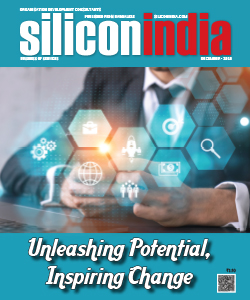Increased Adoption of Digital Transformation in the Government Sector

An alumnus of the esteemed IIT Kharagpur, Atlanta is a seasoned industry professional with over two decades of cross-functional experience across various multinational technology conglomerates. In a recent interaction with Siliconindia, Atalanta Kar, Vice President & Global Head - Sales & Client Relations, Nihilent shared his valuable insights on various aspects pertaining to how digital technologies the government sector in the country. Read further to know more about these interesting topics
How is the government sector in India traversing through the digital transformation phenomenon lately?
Given the massive impact that digital technologies have on our daily life, the government sector has shown a heightened interest towards embracing digital tools in recent years. Thus, the country is experiencing a substantial acceleration in the digital transformation of both state and central government departments, focusing on internal processes and citizen services. Digital channels now serve as the primary means for most government departments, with a significant transformation observed in essential areas like healthcare, exemplified by the Aarogya Setu app. This app facilitated the distribution of health services and played a crucial role in managing one of the world’s largest vaccination programs during the covid pandemic.
Additionally, landmark initiatives such as the Digital India program, Pradhan Mantri Grameen Digital Saksharta Abhiyan (PMGDSA), and Unified Payments Interface (UPI) have positioned India as a digitally empowered society and a key player in the digital economy. Aadhaar - the world’s largest biometric identity system, and DigiLocker - a secure digital document storage platform, exemplify the success of this strategy, enabling over a billion people to participate in the digital economy. This emphasis on digital platforms has enhanced efficiency, transparency, and the overall experience for citizens and enterprises. However, there is still significant potential for the Indian government to enhance services further. The focus is shifting towards sustainability-related technologies as the country pursues its sustainability targets.
Tell us about a few cutting-edge technologies that are driving the digital transformation wave, along with their use cases.
Technology integration plays a pivotal role in streamlining operations across both government and private sector organizations. Anticipated digital interventions in government infrastructure operations include intelligent operations driven by technologies such as IoT, AI, and robotics, reflecting an ongoing commitment to advancing digital capabilities for the benefit of the people of India. While AI enhances data analysis, decision-making, and citizen services, blockchain ensures secure transactions, especially in identity verification and supply chain management. Additionally, IoT monitors and optimizes public infrastructure, while Robotic Process Automation (RPA) boosts administrative efficiency, and cloud computing fosters seamless collaboration and scalability. Collectively, these technologies drive responsive, transparent, and efficient government services.
Suggest a few ways in which government organizations can leverage digital transformation to enhance their service efficiencies.
Digital tools such as automation, AI and data analytics can help the government operate more efficiently by automating tasks, streamlining processes, cutting costs, and making better decisions. Also, cloud technologies and integration methods can connect different government departments, making operations smoother. Additionally, advanced surveillance and digital planning systems also contribute to better disaster response. While the advantages of leveraging digital technologies are endless, it is also important to remember that the main goal of these changes should be to improve the lives of citizens and communities. Thus, the government should focus on creating real benefits for people by leveraging user-friendly systems that consider the diverse needs of citizens across all demographics. Furthermore, a clear plan and a proper understanding of the impact on citizens and employees are essential for the effective implementation of digital transformation initiatives.
What are some of the pros and cons of government bodies outsourcing their digital transformation initiatives?
Outsourcing digital transformation initiatives presents both advantages and challenges for government bodies. On the positive side, partnering with external entities brings-in specialized expertise that may not be available in-house. The extensive experience and knowledge of digital technologies that these partners have allow for more efficient and effective execution of transformation projects. Additionally, outsourcing can lead to cost savings, as it reduces the need for significant investments in infrastructure, technology, and skilled personnel. Government bodies can also benefit from the flexibility and scalability offered by outsourcing, allowing them to adjust resources based on evolving needs.
A major concern with outsourcing is the loss of control over certain aspects of the transformation process. Entrusting critical functions to third parties may result in a dependency on external vendors and a reduced ability to oversee and manage the project internally. Moreover, security is a significant concern when dealing with sensitive government data, as it raises concerns about data privacy and security breaches. Communication barriers may also arise due to differences in location, culture, and language between the government body and the outsourcing vendor. Lastly, overreliance on outsourcing vendors can pose risks in case of a strained relationship or issues with the vendor, potentially disrupting ongoing projects and services.
To conclude, while outsourcing digital transformation initiatives offers several benefits such as enhanced expertise, cost savings, and scalability, government bodies must carefully weigh these advantages against the potential risks. Also, effective management and clear communication are essential to mitigate these risks and ensure successful outcomes in outsourced digital transformation projects.
How do you expect the digital transformation in the Indian government sector to evolve in the near future?
Of late, the Indian government has been emphasizing a lot on the digital-first approach by launching various initiatives and collaborating with local & global partners, startup ecosystems, device OEMs, academic institutions, and research institutes. Going forward, the use of predictive analytics and AI-driven decision-making is expected to increase, improving policy planning and citizen services. Also, e-governance initiatives will expand further, making services more accessible and efficient for citizens. Blockchain might be integrated more to enhance transparency in public transactions like land records and supply chain management. Also, the adoption of emerging technologies such as 5G and IoT can lead to smarter cities, improved utility services, connected infrastructure, intelligent transportation, and better infrastructure management. However, it is crucial to implement cybersecurity measures to safeguard sensitive data.
Read More News :
Evolving Cyber Attacks in Today's Gen AI Era
Emerging Trends & Applications Reshaping Downstream Aluminium Sector in India

.jpg)


.jpg)
.jpg)